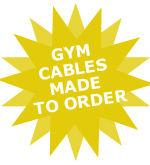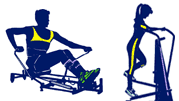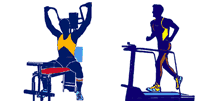Preventive Maintenance
Importance of Preventive Maintenance
of Fitness Equipment
Participation in a fitness program can offer many benefits
to an individual including more stamina, stronger muscles and bones,
less susceptibility to depression and disease, etc. In general, it impoves
one's mental and physical health.
 However, the owner of the fitness equipment used in such
a program can contribute to opposite results if the people using the
equipment are injured due to neglected equipment. Serious injuries or
even death can result from poorly maintained fitness equipment. On strength
equipment, cables can break or jam, welds can fail. Treadmills can suddenly
speed up tossing the user backwards or suddenly stop, in effect, propelling
the user forward. Dusty motor compartments can cause fires. Frayed wires
can cause electrical shock, cracked covers on the equipment can cut skin,
loose covers can come off exposing moving parts, seats can get wobbly
and cause back problems due to misalignment of the body in order to compensate,
etc. However, the owner of the fitness equipment used in such
a program can contribute to opposite results if the people using the
equipment are injured due to neglected equipment. Serious injuries or
even death can result from poorly maintained fitness equipment. On strength
equipment, cables can break or jam, welds can fail. Treadmills can suddenly
speed up tossing the user backwards or suddenly stop, in effect, propelling
the user forward. Dusty motor compartments can cause fires. Frayed wires
can cause electrical shock, cracked covers on the equipment can cut skin,
loose covers can come off exposing moving parts, seats can get wobbly
and cause back problems due to misalignment of the body in order to compensate,
etc.
Therefore, it is incumbent upon the party responsible
for the equipment to maintain it properly. Preventive maintenance is
the best way to do that by keeping the equipment functioning the way
it was designed to work and by detecting and rectifying problems before
they become catastrophic. Besides keeping the equipment safe, a preventive
maintenance program has the added benefit of minimizing the cost of upkeep
by providing the option to repair items while the issues are minor. Worn
or defective parts that are not replaced in time often result in damage
to adjacent parts, motors or expensive electronics.
The preventive maintenance should be scheduled, comprehensive
and performed by qualified technicians who are experienced and have access
to technical support.
What
is Preventive Maintenance?
1. General
Preventive Maintenance
- Perform a safety
inspection to include an observation of weldments, seat supports, chains,
pulleys, cables and a check for missing or worn hardware, etc.
- Upholstery items
will be inspected for wear and tear, rips, cuts, and sharp edges. Mounting
bolts will be checked for tightness.
2. Lubrication
- Lubrication of
all chains, sprockets, rollers, guide rods, seat adjustments, threaded
rods, pivot points and the like where appropriate.
3. Cleaning
- The Servicer will
clean the inside of equipment where appropriate. e.g. The motor compartments
of treadmills or any units that have optical sensors. The usual housekeeping
of the exterior will be the responsibility of the owner.
- Before Lubrication,
the guide rods of all strength equipment will be cleaned.
4.
Electrical Components and Electronics
- The Servicer will
inspect all line cords, power supplies, batteries and similar devices
for safety and functionality.
- Inspect all electrical
connections and wire insulation
- Test electronics
and calibrate where necessary.
5. Performance
Test
- After the preventive
maintenance has been completed to a unit, it will be tried by the Servicer
to insure the overall performance and integrity of that unit.
6. Commercial
Verification
- Upon completion
of the scheduled preventive maintenance visit, a completed checklist
including a description of parts and repairs deemed appropriate by
the Servicer will be given to the Owner’s representative. All
necessary repairs and replacement parts must be approved by the Owner
or the Owner's representative.
|





